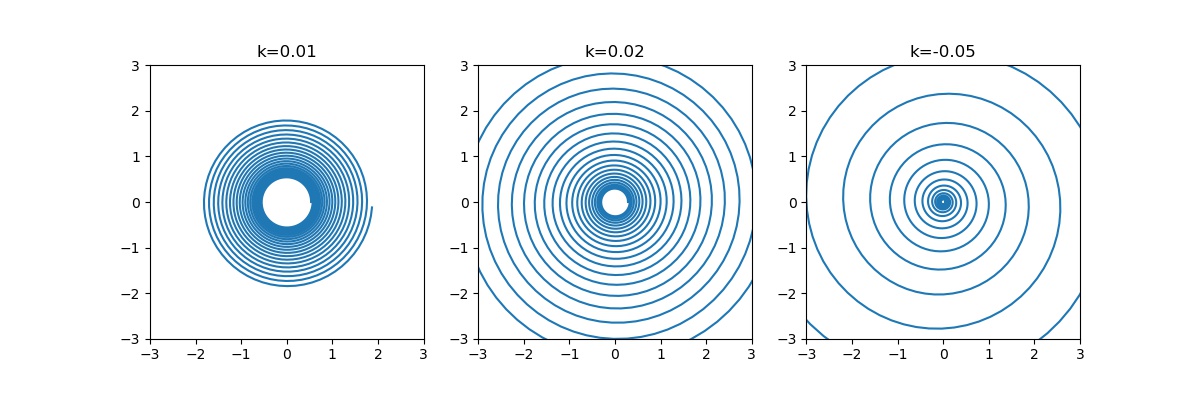Arc Length
Defining arc Length
For a vector \(v\), the length is defined as \(\|v\| = \sqrt{v_1^2 + \cdots + v_n^2}\).
For vector \(u, v\), \(\|u-v\|\) is the length of the line segment joining \(u, v\).
Consider a parameterized curve \(\gamma\), and an arc from \(\gamma(t_0)\) to \(\gamma(t_1)\). We can partition the curve into many points, and then approximate the length by summing the length of the line segments joining the points.
One easy partition is to partition by adding a small step \(\delta t\) from previous time step \(t\). Hence for an arbitrary segment of the curve between \(\gamma(t)\) and \(\gamma(t+\delta t)\), its length is then approximated by \(\|\gamma(t+\delta t) - \gamma(t)\|\). Since \(\delta t > 0\) and it's taken arbitrarily small,
Therefore, the arc is then approximated as
Therefore, the arc-length of a curve \(\gamma\) starting at \(\gamma(t_0)\) is a function \(s(t)\) given by
Note that - \(s(t_0) = \int_{t_0}^{t_0} = 0\) - \(\forall t > t_0. s(t) > 0\) - \(\forall t < t_0. s(t) = \int_{t_0}^{t} \|\gamma'(u)\|du = -\int_{t}^{t_0} \|\gamma'(u)\|du < 0\)
Also, if we choose a different starting point \(t_1\), the resulting arc-length \(s_1\) differs from \(s\) by a constant \(\int_{t_0}^{t_1} \|\gamma'(u)\| du\)
Example: Logarithmic spiral
Parameterize the a logarithmic spiral as
Source code
import numpy as np
import matplotlib.pyplot as plt
t = np.arange(-20 * np.pi, 20 * np.pi, 0.1)
def log_spiral(t, k):
plt.gca().set_aspect('equal')
plt.plot(np.exp(k * t) * np.cos(t), np.exp(k * t) * np.sin(t))
plt.xlim(-3, 3)
plt.ylim(-3, 3)
plt.title(rf"k={k}")
plt.figure(figsize=(12, 4))
plt.subplot(131); log_spiral(t, 0.01)
plt.subplot(132); log_spiral(t, 0.02)
plt.subplot(133); log_spiral(t, -0.05)
plt.savefig("../assets/arc_length.jpg")
Then, we can find its arc length by
Example: Catenary
The catenary parameterized with \(\gamma(t) = \cosh t\). Determine the arc-length starting at \((0, 1)\).
Speed
Treat \(\gamma(t)\) as the position of a particle at time \(t\), then the arc-length \(s(t)\) can be seen as the distance traveled by the particle. Therefore, we can define speed as \(\frac{ds}{dt}\) since \(s\) is definitely differentiable.
For a parameterized curve \(\gamma\), its speed at \(t\) is defined as \(\|\gamma'(t)\|\).
\(\gamma\) is said to be a unit-speed curve if \(\forall t \in (a, b). \|\gamma'(t)\| = 1\).
Lemma For some function \(\mathbf n: (a, b)\rightarrow\mathbb R\) s.t. \(\mathbf n\) is smooth and \(\forall t. \|\mathbf n(t)\| = 1\). Then, \(\mathbf n'(t)\cdot\mathbf n(t) = 0\).
proof. Assume \(\mathbf n\) is smooth, then \(\mathbf n\) and \(\mathbf n'\) are both differentiable. Therefore, consider
Also we know that
Therefore,
Corollary If \(\gamma\) is a unit-speed curve, then \(\gamma'' = 0\) or perpendicular to \(\gamma'\).
proof. Take \(\mathbf n = \gamma'\), \(\gamma''\cdot \gamma' = 0\)
Example
Show that \(\gamma(t) = (\frac{1}{3}(1+t)^{3/2}, \frac{1}{3}(1-t)^{3/2}, \frac{t}{\sqrt{2}})\) is unit-speed.
Show that \(\gamma(t) = (\frac{4}{5}\cos t, 1 - \sin t, \frac{-3}{5}\cos t)\) is unit-speed.
Example
Claim A straight line is the shortest curve joining two given points.
proof. Let \(\mathbf p, \mathbf q\) be two points, \(\gamma\) be an arbitrary curve passing through with \(\gamma(a) = \mathbf p, \gamma(b) = \mathbf q, a < b\).
Take \(\mathbf u = \mathbf p - \mathbf q, \hat{\mathbf u} = \frac{\mathbf u}{\|\mathbf u\|}\) so that \(\|\hat{\mathbf u}\| = 1\). Note that
So that
